[With Cuckoo Paul and Sveta Basraon]
Iftar at Bhendi Bazaar (aka Bohri Mohalla) in South Mumbai is a sensory overload. Every evening, in the holy month of Ramzaan, the food businesses take over the streets as they expand their kitchen and set up tables on the sidewalks, lit up with fairy lights. You’ll find gourmands from all walks of life and faiths rubbing shoulders with Muslim families breaking their roza.
Many of the decades-old food businesses here are iconic—Haji Tikka (for kebabs), Surti Bara Handi (for slow cooked meat preparations, each in a separate gravy), JJ Jalebi (for mawa jalebi), Firoze Farsan, Salman Pulao, Tawakkal Sweets, Taj Icecream (for hand churned fresh fruit ice cream) and many more.
The food stalls are easy to find—just follow your nose and the crowds. Social media and food bloggers have only driven more people to try the offerings here. Though, it can be intimidating dodging the cars and buses on Mohammed Ali Road to enter the Bazaar, navigating the narrow lanes, deciding what to eat, and jostling for space at the busy food stalls, but it’s worth the effort.
If you’ve never been there before, you could sign up for a food heritage walk. We signed up with Khaki Tours for the #RamzanRamble walk. Two hours of a very informative exploration, absorbing the nuggets on its history, insights into the Dawoodi Bohra community that dominates the area, its culture, the changes imminent from an ambitious redevelopment project. All interspersed with many stops to sample nalli-nihari, a rice-less biryani, kebabs, keema samosa, delicately flavoured pulaos, giant malpua, fresh fruit ice cream, sherbats at Idris and more—peppered with bits on the Gujarati and other influences on the food from our guide Niranjan Pant (name changed on request). (While Ramzaan ends on April 9, Khaki Tours may still offer some food walks in the area at reduced frequency. Many of the food places do operate through the year and some are even available on food delivery apps.)
A sampling from the food walk

[Starters: Kebabs and more at two popular outlets — Haji Tikka and Indian Hotel. One is spoilt for choices.]
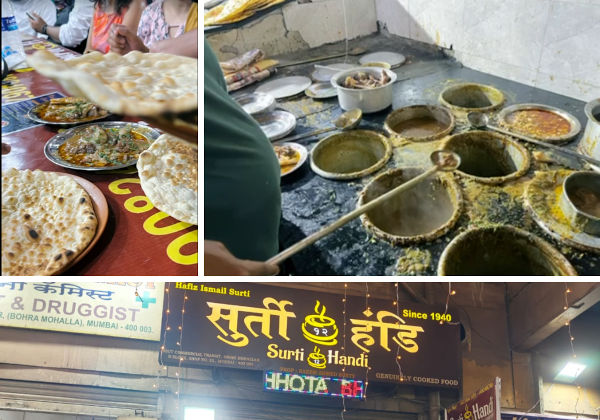
[Surti Bara Handi: From paya, to nalli, nihari and more. No generic gravy here; each preparation is slow-cooked in separate pots]
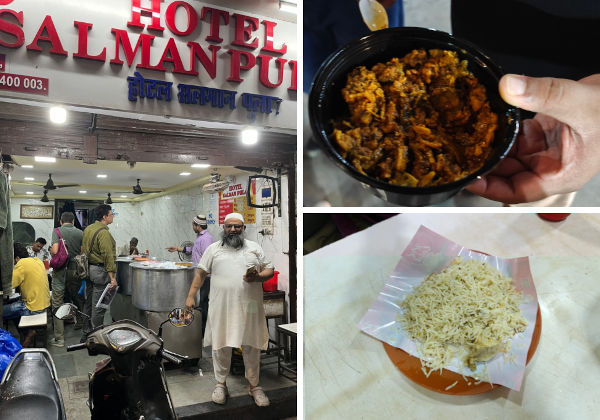
[Something special for biryani lovers: The aromatic and delicately flavoured pulaos at Salman Pulao and a biryani made with no rice are a must-try]

[Indulge your sweet tooth: There’s a lot more here besides the famous Tawakkal Sweets. Clockwise from top: Do try the fennel flavoured sharbat at Idris Cold Drink; hand-churned fresh fruit ice cream at Taj Icecream, and of course the egg malpua with rabdi at Tawakkal Sweets]
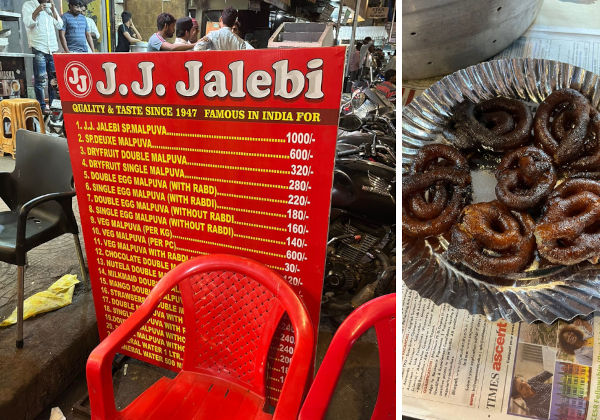
[Jalebi with a twist at JJ Jalebi]
♦¤♦¤♦¤♦
Bohri Mohalla lies in the shadow of the Raudat Tahera, the newly restored and elegant Saifee Masjid, and the twin Al-Sa'adah Towers, the first mixed-use highrises under the redevelopment plan.
These structures tell a story of the push and pull between tradition and modernity that the Mohalla and its people are going through.
The Raudat Tahera is the mausoleum of two of the spiritual leaders of the Dawoodi Bohra community—the Syedna Taher Saifuddin and Syedna Mohammad Burhanuddin. Dawoodi Bohras are Shia Muslims, who came from Egypt, via Yemen and settled mostly in Gujarat.
The Mohalla is where mostly Bohra tradesmen set up shop in the British era. It is one of the most densely populated neighbourhoods in Mumbai. On any given day at the bustling bazaar, its antiques (Chor Bazaar), zari wallas (traders who remove gold and silver from zari from old sarees), timber shops, hardware stores, textiles jostle for your attention amidst the aroma of kebabs wafting through.
The bazaar is at the street-level of the chawls or tenements with dorm-like rooms for the original tradesmen. Eventually entire multi-generational families settled in the congested and crumbling chawls with only a communal bathroom at each floor. Over the past few decades, many of the affluent traders moved to other parts of Mumbai, though they run businesses in the area and many visit the masjid every day.
♦¤♦¤♦¤♦
Twenty six year old Burhanuddin (Burhan for short) is a third generation member of the Badshah family. Burhan’s grandfather Asgerali grew up in Bohri Mohalla. When Burhan’s father Mansoor was still a young boy, Asgarali relocated to Pune in the ’60s and set up Badshah Sweets on MG Road. It was a huge success and became an iconic store in Pune. Later, when he moved to the construction business, the traditional sweetmeat shop didn’t get the attention it deserved and eventually shut down.
In 2018, when his elder brother Fakhrudddin returned to Pune after his studies abroad, both brothers realised construction wasn’t exactly their cup of tea. Egged on by their father, they decided to reopen Badshah Sweets and hired back the old staff. Badshah Sweets quickly regained their old franchise in a different location on MG Road and also found new patrons. Once the reopened store had stabilised, the brothers decided to expand to Mumbai and decided to pick Bhendi Bazaar as the location for their first outlet in Mumbai. If Asgerali were alive—he passed away in 2010–it would gladden his heart to see their family enterprise Badshah Sweets spring up in the same mohalla where he grew up.
A massive change was already underway. The mammoth and complex Bhendi Bazaar redevelopment project was starting to take shape. There was retail space available on rent on the ground floor of the spanking, new Al-Sa'adah Towers, the twin high-rises to come up in 2019.
But the two young men had their concerns: they realised that as a format, Badshah Sweets wouldn’t scale that easily. Product shelf life was limited. And competing with traditional favourites like Tawakkal Sweets in Bhendi Bazaar wouldn’t be easy. They need a different offering. On their trips to Turkey and UAE, Mansoor and his two sons hit upon a Turkish sweetmeat: Kunafa. Mansoor felt it had three ingredients for success in India: it was crisp, was served hot and had liberal doses of cream (malai) inside. They hired a consultant chef from Turkey to get the R&D started. Initially, they sourced the ingredients from Dubai and eventually looked to localise it. In 2022, a small 35 sq ft shop fell vacant, next to Badshah Sweets. In April that year, the Badshah brothers decided to take the plunge and open a small takeaway counter to test their new brand: Kunafa Bytes.

[The Badshah brothers]
They also gambled on the fact that it was Ramzaan. “Bohri Mohalla attracts a diverse population during this holy month,” said Burhan. Kunafa was a novel item. In their guesstimate, only 40% of the people who stepped in were aware of the Turkish sweetmeat. They decided to offer free sampling, to start with.
People flocked to the new outlet in droves. Strong word of mouth ensured that Aamir Munshi also landed up there to try out the Turkish dessert. Unlike the middle class folks at Bohri Mohalla, Munshi came from an upper class Bohri Muslim family, lived in Worli, was well-travelled and had studied abroad. Although their grandfather had moved out of that area decades ago, their imitation jewellery business still flourished in the noisy Crawford market, south of Bhendi Bazaar. He would visit the area occasionally. Munshi says he was already familiar with Kunafa. Unlike mithai, the idea of a more contemporary Turkish dessert which he was already familiar with, struck a chord with the 30 year old.
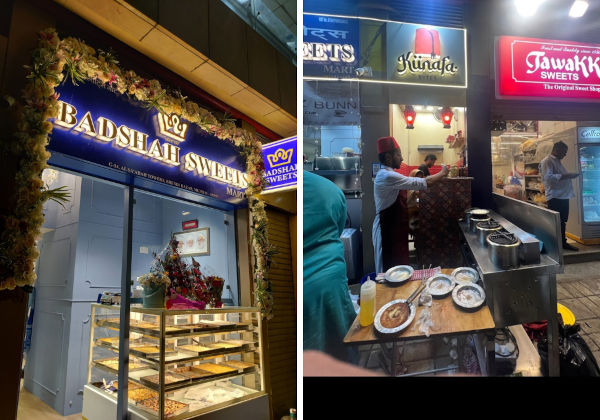
[The Badshah Sweets outlet at the Al-Sa'adah Towers; and the Kunafa takeaway counter at Bhendi Bazaar]
Burhan says the initial response convinced the Badshah family that there was indeed a market for Kunafa Bytes. They quickly positioned Kunafa Bytes as a quick service restaurant (QSR) where people could actually sit, enjoy and share the dessert with family and friends. The average bill value was a lot higher, their R&D ensured that it would have a longer shelf life, and it could be shipped from a central kitchen in Pune. Today, Kunafa Bytes is spread across 11 locations in seven cities in India. Eight percent of their total turnover now comes from Kunafa Bytes.
While Burhan acknowledges that the fillip for a national QSR chain came from their Bhendi Bazaar test market, they have no immediate plan to launch a QSR format in Bohri Mohalla. By now, the takeaway format had already gained acceptance. Besides, while the redevelopment project is gradually starting to win back more people from adjoining areas, the turnover still tends to have a very strong skew in the month of Ramzaan. “More than 25 percent of our sales come from that one month alone,” he said. For other outlets, that number could be even higher. In fact, thanks to the surge in demand during Ramzaan, Tawakkal prefers to open multiple outlets in the locality. While they pay rent all round the year, these satellite outlets are opened only during Ramzaan. “Our outlet is flanked by Tawakkal on both sides,” said Burhan.
In fact, many of the delicacies like malpua and rabdi aren’t widely available once Ramzaan is over. Only limited quantities are made, since demand tends to reduce drastically after Ramzaan. The hope is that the redevelopment project might even out the visitor footfalls in the areas round the year. Some of that is already starting to take shape. On September 27 last year, the newly restored and elegant Saifee masjid, the largest of its kind in the city, opened its door, drawing thousands of Bohri worshippers, both from the area as well as from elsewhere. The more than 100-year-old masjid has ample space, can accommodate about 5,000 people and is centrally air conditioned.
“We immediately saw a surge in footfalls because of the new workshippers,” says Pant, our affable Khaki tours guide. Munshi says his devout mother makes almost daily trips to Saifee masjid during Ramzaan.
As the cluster development takes shape, the gentrification of Bhendi Bazaar is underway. Already, the roads leading up to the towers are getting concretised. Street vendors are being asked to relocate. Old, dilapidated buildings are being demolished. Former tenants and owners are being offered ownership space in the new towers, replete with modern amenities, including a prayer hall, proper security, play area for children and car parking. On cue, residents are starting to buy their own cars. Commercial establishments are being asked to pay close heed to fire safety and proper waste management norms in these new towers.
It may take a while before the chaos of relocation settles down though. Residents and commercial establishments are being asked to move to transit accommodation, till their permanent establishments are ready. Surti Barahandi, one of the most popular outlets and an eternal favourite for meat lovers, has had to shift to a new location three times in the last couple of years. Word of mouth ensures that foodies discover it without too much effort.
In phase two of the redevelopment plan, two new 53-storied towers—Al Ezz and Al-Nazr—are in rapid construction. Once ready, it will house 1,250 families and around 270 businesses, according to a February 18 report published in The Times of India. The redevelopment is self-funded by the Saifee Burhani Upliftment Trust (SBUT), a not-for-profit public charitable trust. It has a tradition of supporting small Bohri businesses with interest free loans.
In the midst of this massive transformation, visitors to the area would hope that the eternal vibe of the place, the gastronomic delights, the old mohalla spirit and its old world charm does not disappear.
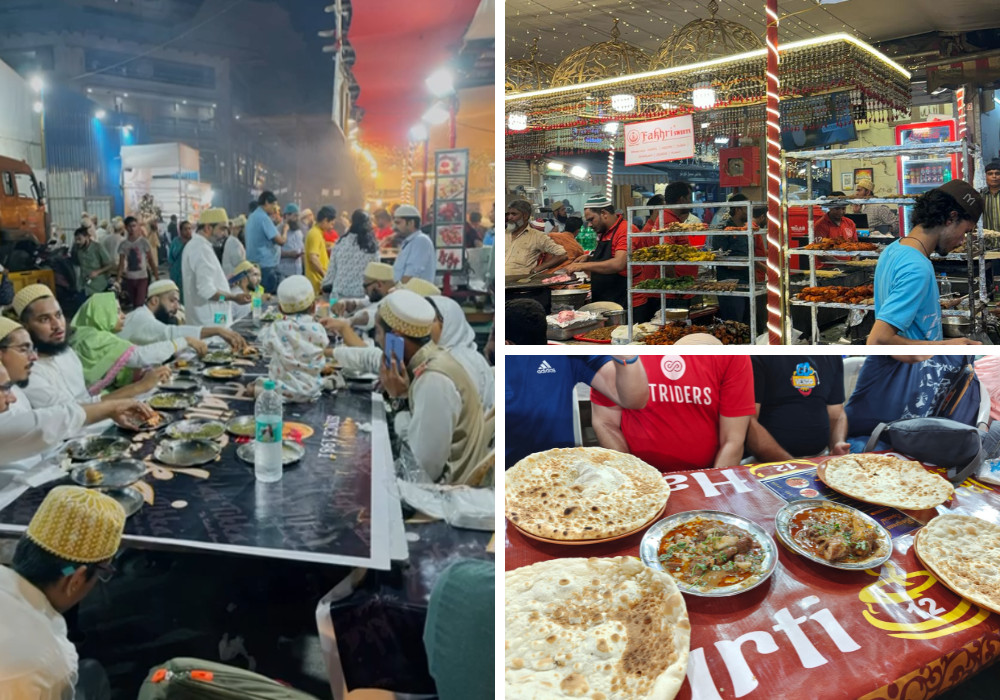


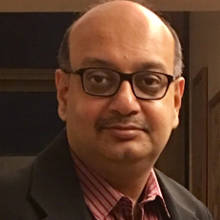
VIVEK PATWARDHAN on Apr 06, 2024 5:03 a.m. said
Great story. Thanks for bringing this to us. I have read somewhere that anything which is stuffed probably originated in Türkiye. Maybe in Persia. The word Tavaa (Griddle), commonly used by Maharashtrians also has origins in Persian language. Someone mentioned that even Puran Poli which is a sweet made in Maharashtra and almost all southern states, has its origin in the culinary practices of Türkiye. I could not find anything on the internet to support this view though. Wikipedia says 'Its recipe (as bakshyam) is mentioned in Manucharitra in the 14th century'. But we should note that the Khilji dynasty (he belonged to a Turkish Tribe) ruled from 1292 A.D. to 1320 A.D. On my recent trip to London I was amazed to see a 'Karanji' displayed at a restaurant but they told me that it was 'Empanada'. Needless to say, the filling was different, but the appearance was identical. This is also made in Maharashtra in Diwali and it is made differently by different communities. Brahmins make Karanji and Kayasthas make Kanole! Same product with slightly different way of making. The filling is different. Portugese reached our kitchen centuries ago! And I have eaten a Hapus mango in my breakfast today, Indianised name for Alphonso, and named after Afonso de Albuquerque. Interestingly Puran Poli, Karanji, Kanole and Hapus mango are offered to the God regularly as 'Naivedyam.' Religion and Regional boundaries are not recognised when it comes to delicious food!